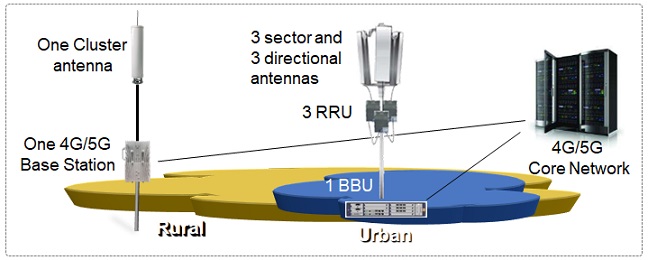The purpose of 4G/5G Mobile Edge Coverage solution is providing low capacity and large coverage wireless access network for telecom operators in the specified areas. These specified areas include remote rural, mountain area, rural roads, remote highway, tunnels of highway or railway and so on. The Mobile Edge Coverage solution is based on the integrated 4G/5G Base Station and cluster or directional antenna, which can provide lower cost wireless access network solution for telecom operators to cover those areas above.
The baseband and RF functions have been built in the integrated Base Station, which is compliance with LTE or 5G NR standard defined by 3GPP and has the higher cost performance. The integrated Base Station has the characteristics of small size, light weight, convenient deployment and maintenance to reduce the operators’ CAPEX and OPEX effectively. The integrated Base Station has higher RF power and can cover larger range with high gain cluster or directional antenna.

Network architecture diagram of 4G/5G Mobile Edge Coverage
1. Typical coverage Scenarios
Scenario 1: rural areas 4G/5G coverage
In rural areas with wide coverage but low capacity request of telecom operator, the integrated 4G/5G Base Station and cluster antenna can provide large coverage by accessing the operator’s existing 4G/5G Core Network. The integrated 4G/5G Base Station can inter-work with other vendor’s 4G/5G Base Station at the coverage boundary.

4G/5G coverage diagram of Scenario 1
Scenario 2: highway and tunnels 4G/5G coverage
In road and tunnel coverage scenarios, two integrated 4G/5G Base Stations and directional antennas can build two 4G/5G cells and cover roads and tunnels.

4G/5G coverage diagram of Scenario 2
Scenario 3: mobile edge network shared by multi-operators
in areas with wide coverage but low capacity request of telecom operators, the operators can share the coverage at mobile edge. The integrated 4G/5G Base Stations and cluster antennas provide large coverage by accessing these operators’ existing 4G/5G Core Network. According to the network coverage sharing protocols, the customers of different operators can share the 4G/5G coverage resources in these areas at same time.
![]()

4G/5G coverage diagram of Scenario 3
2. Highlights of Mobile Edge Coverage solution
Save CAPEX: Compared with the traditional BBU+RRU solution, it can save at least 20% of the cost, and special scenarios can save more than 60%.
Save OPEX: The integrated 4G/5G Base Station does not need an equipment room to deploy, which can save the rental cost for equipment room. The integrated Base Station has lower maintenance cost than distributed Base Station. The integrated 4G/5G Base Station is easier to be maintained and can reduce the labor cost.
Easy installation: The integrated 4G/5G Base Station has small size and light weight, which is convenient to be hold on poles or hanged on the wall.
Convenient O&M: The baseband and RF function have been built in the integrated 4G/5G Base Station and the maintenance is easy and convenient. The integrated 4G/5G Base Station is successfully connected to EPC or 5GC Core Network of mainstream vendors.


+86-10-62060415




